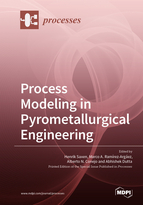Process Modeling in Pyrometallurgical Engineering
A special issue of Processes (ISSN 2227-9717). This special issue belongs to the section "Process Control and Monitoring".
Deadline for manuscript submissions: closed (30 September 2020) | Viewed by 153428
Special Issue Editors
Interests: process systems engineering; modeling; optimization; energy systems; iron- and steelmaking
Special Issues, Collections and Topics in MDPI journals
Interests: mathematical and physical modeling of materials processing; CFD analysis; optimization techniques; steelmaking; aluminum degasification; sand casting
Interests: slag/metal reactions; fluid flow phenomena in ladles; EAF steelmaking; gas/solid reactions
Special Issues, Collections and Topics in MDPI journals
Special Issue Information
Dear Colleagues,
The metallurgical industry today faces several main challenges. The most pressing ones are using less virgin raw materials and lowering the environmental impacts of the processes, in particular, reducing CO2 emissions. With a growing world population and standard of living, it is not possible to base production on recycled materials only. Therefore, existing processes must be improved and optimized in order to minimize material demand, losses, and emissions, while simultaneously keeping them profitable. A key issue for achieving these goals is to intensify and improve the processes by innovative use of mathematical simulations and optimizations.
Pyrometallurgical processes involve complex interactions of phenomena distributed in space and time, at high temperatures, and in a hostile environment, which makes measurements of the conditions difficult or sometimes impossible. Still, deep knowledge of the behavior is needed in order to master and control the conditions appropriately. The coexistence and interaction of many phases is characteristic of the unit processes in this industry. The solid phases are often particulate, such as the raw materials used in pelletizing, sintering, and in the blast furnace, exibiting a complex flow behavior. In steelmaking, hydrodynamic and kinetic interactions between dispersed bubbles and droplets of metal or slag are of fundamental importance. Insight into the phenomena is a prerequisite for process intensification and better metal recovery through a systematic phase separation, but the mechanisms are complicated and coupled. The behavior of metallic droplets in molten slag is linked with slag–metal reaction kinetics, but also with heat transfer and turbulent mixing.
A quantitative estimation of the efficiency of any process and improvement can be made by a systematic approach, applying experiments and modeling. As an example, physical (water) modelling can be used to scale-down (i.e., simplify the industrial experimental situation), so as to closely observe the process. Combined with proper numerical simulations, for example, based on computational fluid dynamics (CFD), a deeper insight can be gained on the interactions at high temperatures, which is the basis for proposing improvements in process design and operation. Physical and mathematical modeling are the modern tools that are used to explore the reaction mechanisms and process improvements in more detail.
The goal of this Special Issue on “Process Modeling in Metallurgical Engineering” is to highlight the recent advances in the development and application of process modeling in metallurgical engineering, and how modeling and simulation can be applied to improve and intensify the processes in the metallurgical industry. The ultimate goal of the Issue is to receive contributions on the modeling and simulation of the pyrometallurgical processes in order to show the advancements in the field and the tools that may be used to understand, control, and optimize current processes, and to design new ones. Topics to be considered include, but are not limited to, the following:
- Transport phenomena and modeling unit processes in pyrometallurgy
- Modeling of slag–metal interaction and related phenomena
- Multiphase flows in metallurgical processes (e.g., in blast furnace, direct reduction, BOF, EAF, LMF, RH, continuous casting, etc.): experimental and modeling approaches
- Modelling techniques for studying metallurgical phenomena at elevated temperatures
- Process modeling, supervision, and control in pyrometallurgy
- Innovative process developments in the metallurgical industry
- Development of sustainable pyrometallurgical processes
Prof. Dr. Henrik Saxén
Prof. Dr. Marco A. Ramírez-Argáez
Prof. Dr. Alberto N. Conejo
Dr. Abhishek Dutta
Guest editors
Manuscript Submission Information
Manuscripts should be submitted online at www.mdpi.com by registering and logging in to this website. Once you are registered, click here to go to the submission form. Manuscripts can be submitted until the deadline. All submissions that pass pre-check are peer-reviewed. Accepted papers will be published continuously in the journal (as soon as accepted) and will be listed together on the special issue website. Research articles, review articles as well as short communications are invited. For planned papers, a title and short abstract (about 100 words) can be sent to the Editorial Office for announcement on this website.
Submitted manuscripts should not have been published previously, nor be under consideration for publication elsewhere (except conference proceedings papers). All manuscripts are thoroughly refereed through a single-blind peer-review process. A guide for authors and other relevant information for submission of manuscripts is available on the Instructions for Authors page. Processes is an international peer-reviewed open access monthly journal published by MDPI.
Please visit the Instructions for Authors page before submitting a manuscript. The Article Processing Charge (APC) for publication in this open access journal is 2400 CHF (Swiss Francs). Submitted papers should be well formatted and use good English. Authors may use MDPI's English editing service prior to publication or during author revisions.
Keywords
- mathematical modeling
- computational fluid dynamics
- metal–slag interaction
- population balance
- physical modeling
- process metallurgy
- process optimization
- sustainable development









